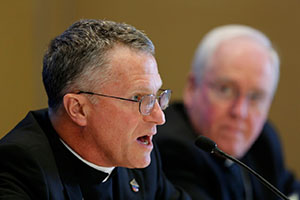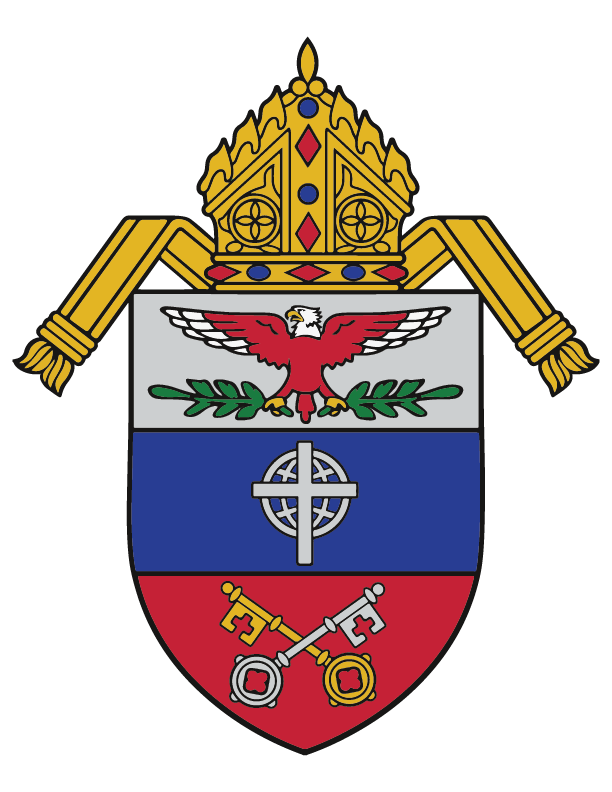“I may soon be unable to provide Catholic priests to the military,” he tells General Assembly of United States Conference of Catholic Bishops

BALTIMORE—Calling the shortage of Catholic priests in the U.S. armed forces “desperate,” Military Services Archbishop Timothy P. Broglio said Monday he may soon be “unable to provide Catholic priests to the military,” unless his brother American bishops release more priests to serve as chaplains. In remarks to the General Assembly of the United States Conference of Catholic Bishops (USCCB), Archbishop Broglio painted a sobering outlook for rank-and-file access to Catholic pastoral service and ministry in the military.
“Next year the Army, heretofore stable in the number of priests in uniform, will lose at least eleven to retirement and separation for medical reasons,” Archbishop Broglio said. “The Navy, which serves Navy, Marine Corps, and Coast Guard has 48 priests today of whom 36 can be deployed but by June there could be a reduction due to retirements.” Archbishop Broglio said the Air Force currently at 56 priests will also be losing priests in June. “Approximately, one fourth of the active-duty personnel and their immediate families are Catholics,” he said. “At present those Catholics– totally around a million people– are served by only 217 priests in a territory that covers the globe. They represent only 8% of all military chaplains.”
Archbishop Broglio warned the Catholic chaplain shortage is leaving young Catholic servicemen and women open to proselytization from non-Catholic religious groups with their own active youth ministry programs. “They offer them as ecumenical, but they are generally based on a very Protestant or even a fundamentalist approach,” he said. Archbishop Broglio called on his brother bishops to help meet the challenge by releasing more priests for military service. “If your diocese does not have a priest serving as an active-duty military chaplain,” he urged, “please consider releasing one to serve the Catholics of your diocese who wear a uniform and are far from home.”
Here follows the complete text of Archbishop Broglio’s remarks:
“Your Eminences, Brother Bishops and Priests, Sisters and Brothers in the Lord,
“My first words are of gratitude: to the members of the Administrative Committee who granted me the opportunity to address you once again about a pastoral problem that affects all of us. Secondly, I thank the Ordinaries of the 179 dioceses and eparchies who took up the special collection in 2013 to support your faithful who are my pastoral responsibility at the present moment. The collection was very successful and I hope that such will also be the case in next year when it is scheduled again.
“If the financial situation of the Archdiocese for the Military Services, USA, has improved, which thanks to you, it has, the presence of priests has dwindled to the point of being desperate. Pope Francis recently told military ordinaries from around the world that “The role of military chaplains is to accompany and support [those in need] on their journey, to be a comforting and brotherly presence for them all.” (Pope Francis, Address to participants in the Humanitarian Course, 26.X.15.) I may soon be unable to provide Catholic priests to the military. Next year the Army, heretofore stable in the number of priests in uniform, will lose at least eleven to retirement and separation for medical reasons.
“The Navy, which serves Navy, Marine Corps, and Coast Guard has 48 priests today of whom 36 can be deployed but by June there could be a reduction due to retirements. The Air Force also faces a drop from the current 56 priests. The numbers mean that it will be almost impossible to ensure that men and women even in deployed locations and on aircraft carriers will have access to a Catholic priest. If the Armed Forces were ever to be completely without priests, most observers agree that they would soon be completely without chaplains of any kind.
“Approximately, one fourth of the active-duty personnel and their immediate families are Catholics. At present those Catholics– totally around a million people– are served by only 217 priests in a territory that covers the globe. They represent only 8% of all military chaplains. That suggests that others might easily cultivate Catholic young people seeking spiritual counsel.
“Some very well-organized groups eagerly present programs for youth ministry. They offer them as ecumenical, but they are generally based on a very Protestant or even a fundamentalist approach to faith. If there is no priest there to lobby for funds for a Catholic program or to sponsor an alternative, the program appears to be very appealing to the leadership on an installation who grant the necessary resources to that program. They are convinced that they have provided for youth and young people in the area of spiritual concerns.
“I feel a bit like Mother Cabrini, the first saint with an American passport to be canonized. She used to oblige poor families to give her a lump of coal so that she could meet the needs of even poorer families. Indeed I recognize that every archdiocese, diocese, and eparchy is under-staffed and struggling to meet the legitimate needs of the people entrusted to your pastoral care. It is not easy to ask you to sacrifice a young, physically fit priest to care for that portion of your flock that is out-of-sight and under my care as long as they are active duty, but the dire situation leaves me few other viable options.
“I am grateful for the many retired priest who take contracts on military installations. They respond to a great need. However, they are restricted to the chapel, have little access to work areas, do not counsel the leadership, and have less influence in the decision-making process.
“Certainly, consultative bodies in a diocese have a role to play in the assignment of priests, but fundamentally the Ordinary has the vision and also understands the importance of caring for all the faithful. If your diocese does not have a priest serving as an active-duty military chaplain, please consider releasing one to serve the Catholics of your diocese who wear a uniform and are far from home.
“There is also return. The military is the largest single source of vocations in this country. The CARA study for 2015 has revealed that 6% of the newly ordained priests who responded to the survey are prior service and 16% came from families where either the mother or father or both had been or are active duty. 22% of the newly ordained represents a significant contribution to your dioceses, but I am not sure that the AMS can sustain those percentages if there are no priests among the military population. As we all know too well, contact, good role models, and familiarity with the sacerdotal ministry are essential elements to promoting vocations.
“While the Government is reducing the size of the Armed Forces, the world situation, as we just witnessed again dramatically on Friday evening in Paris, continues to make the need for a strong military more evident.
“Please encourage your priests to consider the possibility of serving in the military. You might talk to the recruiters who are in the corridor outside this room. So often seminarians and young priests tell recruiters and me that your Vocation Directors, Personnel Board members, and Vicars General dissuade priests from approaching you about eventual service as a military chaplain. They say, “do not bother the Bishop, because he will say no.” Perhaps, to counter that perception, you could invite a recruiter to address a gathering of priests to illustrate the benefits and the challenges of this ministry.
“The Archdiocese continues to sponsor discernment retreats and has also embarked on an initiative called “For God and Country” to acquaint small groups of priests about the ministry of chaplains and some of the possibilities that are available. The first retreat was very successful and I thank those Bishops who released five of the ten participants for ministry in the military.
“Allow me also to address once again the concern of many Bishops regarding the loss of a priest for twenty years or forever. That is not the only option. You can send a priest for 3-5 years and then send another. The AMS does want some long term commitments, because we need some priests in leadership roles with rank, but also can use many for shorter commitments. There are advantages to the loan of a priest for a short commitment: they receive training, CPE, and other skills. They return to you enriched and better able to serve your people in the diocese.
“I can also cite the example of many priests who have returned to their dioceses and taken assignments. They brought with them a wealth of experience and a new vision.
“While the Archdiocese is also charged with pastoral care of Catholics who are treated or frequent the Medical Centers of the Department for Veterans’ Affairs, I have not made an appeal for priests in that sector. While they are always in demand, recruiting is a bit simpler, because there are no age or weight restrictions. However, the needs of Catholic patients are diligently followed by the AMS.
“The Archdiocese is also charged with the pastoral care of your civilian faithful who serve the Federal Government in non-military capacities outside the borders of the USA. The shortage of priests and means does not really permit a viable attempt to serve those populations who live around the world. From the 33 years I spent outside the US, I am comforted by the knowledge that they are generally assisted by the local dioceses where they live. In fact, those international communities gathered for an English-language Mass would probably bristle at the notion that somehow they might be subject to a US Archdiocese. The local bishops would also have some thoughts on the issue.
“Returning to the need for chaplains, I am again reminded of how, just a year ago, Pope Francis described this noble vocation which is “to dedicate yourself, even at the risk of your own life, to ensuring that the faithful serving to defend your country might not be deprived of the spiritual food they need to survive.” (Pope Francis, de Fairbanks, 8.XI.14.)
“The Archdiocese for the Military Services, USA, is extremely grateful to those local Churches that have sacrificed one or more priests. Faithful served by the AMS are praying even now that you might respond generously to my appeal. For it really is imperative that every diocese have at least one priest to ensure that your faithful who defend our religious freedom do not have to sacrifice theirs.
“Thank you for your support and your kind attention.”
Watch EWTN video at 31:25.
